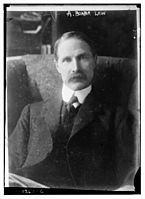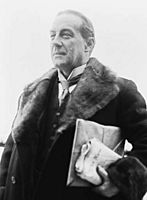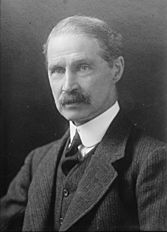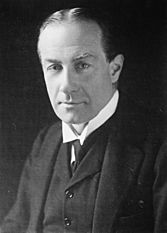Conservative government, 1922–1924 facts for kids
This article is about the Conservative Government in the United Kingdom between 1922 and 1924. This government was made up of two main parts: the Law ministry (from 1922 to 1923) and the first Baldwin ministry (from 1923 to 1924).
These governments were led by two different Prime Ministers: Bonar Law and then Stanley Baldwin. They were chosen for the job by King George V.
Contents
What Was This Government?
The Conservative Government of 1922-1924 was a period when the Conservative Party was in charge of the United Kingdom. This happened right after a big change in British politics. The government before this one, led by David Lloyd George, had fallen apart. This new Conservative government was formed to bring stability back to the country.
Bonar Law's Time in Charge (October 1922 – May 1923)
Quick facts for kids Law ministry |
|
|---|---|
| 1922-1923 | |

Bonar Law
|
|
| Date formed | 23 October 1922 |
| Date dissolved | 20 May 1923 |
| People and organisations | |
| Monarch | George V |
| Prime Minister | Bonar Law |
| Member party | Conservative Party |
| Status in legislature | Majority
344 / 616 (56%)
|
| Opposition party | Labour Party |
| Opposition leaders | Ramsay MacDonald |
| History | |
| Election(s) | 1922 general election |
| Legislature term(s) | 31st UK Parliament 32nd UK Parliament |
| Predecessor | Lloyd George ministry |
| Successor | First Baldwin ministry |
Bonar Law became Prime Minister on October 23, 1922. He was also the Leader of the House of Commons, which meant he was in charge of the main debates in Parliament. His government was formed after the Conservatives won the 1922 general election.
Key People in Law's Cabinet
Law's cabinet included many important figures:
- Bonar Law was the Prime Minister.
- The Viscount Cave was the Lord Chancellor, the highest legal officer.
- Stanley Baldwin was the Chancellor of the Exchequer, responsible for the country's money.
- The Marquess Curzon of Kedleston was the Foreign Secretary, handling international relations.
- William Clive Bridgeman was the Home Secretary, in charge of law and order inside the UK.
- Leo Amery was the First Lord of the Admiralty, overseeing the Royal Navy.
Changes During Law's Ministry
In April 1923, Arthur Griffith-Boscawen resigned as Minister of Health. He was replaced by Neville Chamberlain.
Law's time as Prime Minister was short because he became very ill. He resigned in May 1923 due to his health.
Stanley Baldwin's First Government (May 1923 – January 1924)
| First Baldwin ministry | |
|---|---|
| 1923-1924 | |

Stanley Baldwin
|
|
| Date formed | 22 May 1923 |
| Date dissolved | 22 January 1924 |
| People and organisations | |
| Monarch | George V |
| Prime Minister | Stanley Baldwin |
| Member party | Conservative Party |
| Status in legislature | Majority
344 / 616 (56%)
|
| Opposition party | Labour Party |
| Opposition leaders | Ramsay MacDonald |
| History | |
| Election(s) | 1922 general election |
| Outgoing election | 1923 general election |
| Legislature term(s) | 32nd UK Parliament 33rd UK Parliament |
| Predecessor | Law ministry |
| Successor | First MacDonald ministry |
After Bonar Law resigned, Stanley Baldwin became the new Prime Minister on May 22, 1923. He also kept his role as Chancellor of the Exchequer at first, and was the Leader of the House of Commons.
Key People in Baldwin's Cabinet
Baldwin's cabinet had many of the same people as Law's, but with some changes:
- Stanley Baldwin was the Prime Minister and Chancellor of the Exchequer.
- The Viscount Cave remained the Lord Chancellor.
- The Marquess Curzon of Kedleston continued as Foreign Secretary.
- William Clive Bridgeman stayed as Home Secretary.
- Sir Samuel Hoare became the Secretary of State for Air, looking after the Royal Air Force.
- Neville Chamberlain was the Minister of Health.
Changes During Baldwin's Ministry
In August 1923, Neville Chamberlain took over from Baldwin as the new Chancellor of the Exchequer. Sir William Joynson-Hicks then became the Minister of Health.
Baldwin's government ended in January 1924. He called a general election in 1923, hoping to win a stronger majority. However, the election results meant that no single party had enough seats to form a government on its own. The Labour Party, led by Ramsay MacDonald, then formed a minority government.



